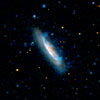Feature Story
Galactic Nature Vs. Nurture
Just as psychologists have pondered the age-old question of "nature vs. nurture" in humans, astronomers are tackling a similar cosmic dilemma -- how much of a galaxy's development is due to innate characteristics, and how much is affected by the surrounding environment?
Now, astronomers using NASA's Galaxy Evolution Explorer (GALEX) hope that a rare sighting -- a spiral galaxy being stripped of its star forming material -- may give them some insights into this age-old question.
"Astronomers typically see spiral galaxies that are gas-rich and actively forming stars, or quiescent galaxies that are gas-poor and no longer forming stars to see a galaxy like NGC 4522 in the process of being stripped of its star forming material is very rare," says Dr. Hugh Crowl, of Yale University, New Haven, Conn.
"This observation presents a perfect opportunity to study how a galaxy's environment affects its evolution."
No galaxy is an island. Almost every galaxy in the universe has a galactic "posse." Astronomers widely agree that interactions between galaxies play a significant role in how a particular galaxy develops. Some believe that galaxies start out as gas-rich spirals, active in star formation. Overtime, interactions with its cosmic environment literally knock the star forming gas out of the spiral galaxy, transforming it into an inactive disk that no longer forms stars.
Meanwhile, Crowl notes that innate phenomena like supernova explosions, and strong winds from black holes and massive stars, also play a significant role in pushing star forming materials out of a galaxy.
"This is an area of ongoing research, we still do not fully understand the extent to which various physical mechanisms are important for the stripping of star forming material from galaxies," he says.
In the case of NGC 4522, Crowl suspects that the galaxy's environment is currently playing a primary role in its development. He thinks that hot-gas surrounding the NGC 4522 is shoving the star forming material out of the galaxy's outer disk in a process astronomers call, "ram-pressure stripping."
Using the ground-based Very Large Array in New Mexico, Crowl's collaborators noticed that NGC 4522's outer disk lacked star forming materials. In addition, a large tail of neutral hydrogen was detected trailing the galaxy. Intrigued, he pointed GALEX's ultraviolet eyes at the galaxy and noticed a relatively young population of hot stars --approximately 100 million years old. Based on these observations, he concluded that the star forming gas and dust in the galaxy's outer disk must have been pushed out within the last hundred million years.
"GALEX is essentially seeing the last generation of stars that will ever form in NGC 4522's outer disk. Seeing those stars is important because they act as an age marker. From this population we can tell when the galaxy had its last episode of star formation and when it stopped forming stars altogether. The age of these stars tells us that NGC 4522 was stripped of its star forming gas at its current location, far from the core of the cluster. This suggests that some galaxies can be stripped in the outskirts of clusters," says Crowl.
"Since the galaxy's outer disk has been stripped of dust, there is nothing blocking our view of ultraviolet starlight. In this sense, GALEX offers us a clear view of NGC 4522's hot, young stars," he adds.
Crowl notes that his next goal is to expand his research to more galaxies.
NGC 4522 is located approximately 100 million light-years away in the Virgo cluster of galaxies. Crowl authored a paper on NGC 4522, which was published in the October 2006 issue of Astrophysical Journal Letter.
Dr. Jeffrey Kenney, also of Yale, was a co-author of the paper. Kenney led the observations of NGC 4522 with New Mexico's Very Large Array.




